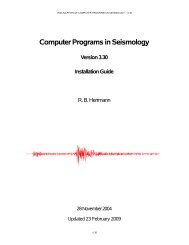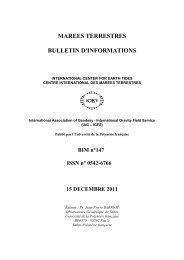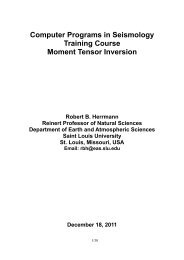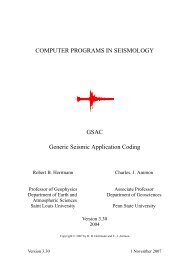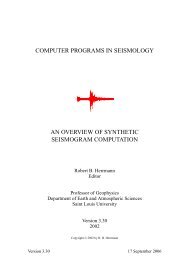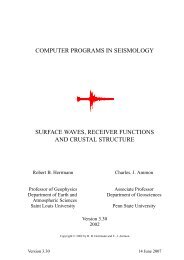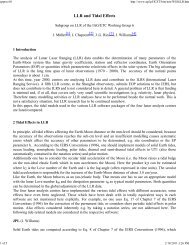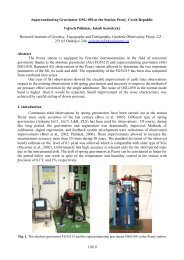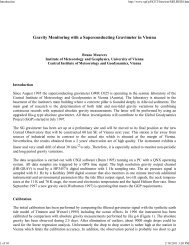3.04 Gravimetric Methods – Superconducting Gravity Meters
3.04 Gravimetric Methods – Superconducting Gravity Meters
3.04 Gravimetric Methods – Superconducting Gravity Meters
You also want an ePaper? Increase the reach of your titles
YUMPU automatically turns print PDFs into web optimized ePapers that Google loves.
86 <strong>Superconducting</strong> <strong>Gravity</strong> <strong>Meters</strong><br />
rotating frame of the Earth’s mantle, but they also lead<br />
to forced nutations of the Earth in the space-based<br />
(nonrotating) coordinate system (e.g., Melchior and<br />
Georis, 1968). There is one tidal wave associated<br />
with each component of the Earth’s nutation. The<br />
most extensive tidal developments now include the<br />
perturbation effects of all the major planets and terms<br />
up to degree 6 for the moon (period 4 h) as well as<br />
terms allowing for the nonspherical shape of the major<br />
bodies. The most recent references on the tidal potential<br />
for gravity work are Hartmann and Wenzel<br />
(1995a, 1995b), Roosbeek (1996),andWenzel (1996a).<br />
There are two approaches to cataloging the TGP.<br />
First, the ephemeris <strong>–</strong> a catalog of apparent positions<br />
of the bodies in the solar system as seen from a<br />
position and time on the Earth; each body is defined<br />
by a longitude, latitude, right ascension, and obliquity.<br />
In this method, an ephemeris tide program (e.g.,<br />
Merriam, 1992a) generates a time series from the<br />
TGP on the surface of a rigid Earth. The accuracy<br />
of this TGP is directly related both to the accuracy of<br />
the ephemeris itself and the analytic theory used to<br />
describe the motions of the planetary bodies. Merriam<br />
estimated for GTIDE an rms time-domain accuracy<br />
of 0.25 nGal, with a maximum error of 0.8 nGal.<br />
Wenzel (1996a) compared three tidal ephemeris<br />
programs: GTIDE as updated in Merriam (1993a),<br />
and two JPL programs DE200T and DE403T that he<br />
used to generate six benchmark gravity tides series.<br />
These series were gravity at 1 h spacing for two<br />
example epochs (1987<strong>–</strong>93; 2017<strong>–</strong>23) at the Black<br />
Forest Observatory (BFO) in Germany (chosen<br />
because of the availability of gravimeter data at<br />
BFO). The internal time-domain accuracy of the<br />
benchmark series derived from the JPL ephemerides<br />
is better than 0.1 nGal, and in the frequency domain<br />
the rms errors are about 100 times smaller.<br />
The second approach, which is a more widely<br />
used method for the TGP, is to sum together a<br />
number of harmonic terms, each of which represents<br />
a partial tide. The frequencies and amplitudes of<br />
these waves can be derived from the ephemerides<br />
by constructing a time series and then filtering it, as<br />
in the CTE potential (Cartwright and Taylor, 1971;<br />
Cartwright and Edden, 1973), or using analytic<br />
means as for the Xi89 potential (Xi, 1987, 1989),<br />
and the potential RATGP95 (Roosbeek, 1996).<br />
Alternatively, the waves can be found by fitting coefficients<br />
to a series based on an ephemeris <strong>–</strong> the<br />
spectral method <strong>–</strong> as used in the Tamura87 and<br />
Tamura93 potentials (Tamura, 1987, 1993) and in<br />
HW95 (Hartmann and Wenzel, 1995a, 1995b).<br />
These TGPs (except for CTE that has now been<br />
superseded) shown in Table 3, are those most commonly<br />
used in high-precision gravity work. They<br />
include tables (catalogs) specifying the frequencies<br />
and amplitudes of the waves (actually wave groups)<br />
that must be summed. By selecting different subsets<br />
of waves, the speed of computation can be adjusted<br />
according to the accuracy required.<br />
Merriam (1993a) compared the catalogs of<br />
Tamura (1987) and Xi (1989) with GTIDE and concluded<br />
that although their differences should be<br />
detectable using SGs, in practice either of the catalogs<br />
could be used for SG analysis. Wenzel (1996a)<br />
compared all the above series and catalogs and concluded<br />
that the HW95 was the most accurate for<br />
high-precision work. Roosbeek (1996) notes this is<br />
expected because HW95 is derived from one of the<br />
benchmark series itself and its only error should be<br />
computational. Tamura93 is widely used as a compromise<br />
between speed and accuracy.<br />
<strong>3.04</strong>.2.2.2 Elastic response of the Earth<br />
Once the tidal forcing series has been accurately<br />
computed for a precise latitude and longitude, it is<br />
necessary to allow for the deformation of the Earth to<br />
compute an approximation to the observed solid tide.<br />
Table 3<br />
Tide-generating potential used in SG data reduction<br />
Catalog # waves # coeffs. Degree Time (ngal) Frequency (ngal)<br />
CTE 505 1010 3 38.44 0.565<br />
Tamura87 1200 1326 4 8.34 0.118<br />
Xi89 2934 2934 4 6.42 0.090<br />
Tamura93 2060 3046 4 3.08 0.046<br />
RATGP95 6499 7202 6 2.00 0.026<br />
HW95 12935 19271 6 0.14 0.002<br />
The last two columns refer to rms accuracies in the time and frequency domains respectively.<br />
Modified from Wenzel H-G (1996a) Accuracy assessment for tidal potential catalogues. Bulletin d9Informations des Marées Terrestres 124:<br />
9394<strong>–</strong>9416.




